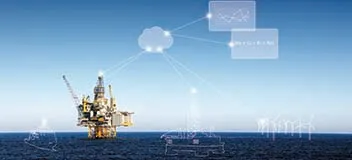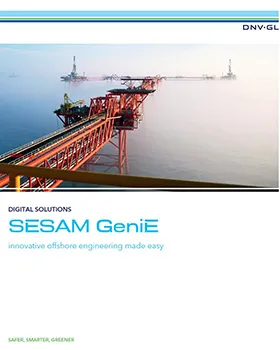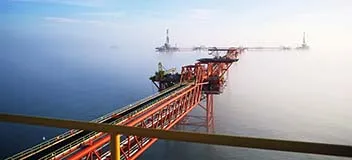He reveals what the ‘stone age’ of three decades ago looked like from the viewpoint of an engineer. There was one thing above all others that would infuriate even the most dedicated engineer.
Sesam - powerful set of tools
“We’ve seen amazing leaps in technology for offshore and maritime engineers,” he says. “In the 1980s we used 15,000 man-hours to create the finite element models for a gravity-based structure in the North Sea. In those days we would create every single node in the mesh manually.”
“Because of limitations in software and hardware at that time, engineers often worked with over-conservative designs,” he says. “The result was that they designed structures that used much too much steel and concrete, and that were very expensive to build.”
Ole Jan Nekstad has been involved with Sesam software since 1981, while he was writing his Master’s thesis at Norwegian Institute of Technology (now NTNU). His professor had created a software program for dynamic analysis of jack-ups. He used the finite element method, a set of principles that had been in use by engineers since the 1960s. NASA had performed analyses on the Apollo spaceship using the same methodology. Ole Jan was given the task of verifying the results using the software that has since become the Sestra module in Sesam. Subsequently, in 1982, Ole Jan got his first job in Det Norske Veritas (DNV).
First he worked as a surveyor for a year, visiting ships and yards. After that he started to use Sesam for design of condeeps, gravity-based structures. In the 1980s he was project manager for finite element analysis of Gullfaks C and Oseberg A in the North Sea. He performed many general finite element analyses and verification analyses of offshore structures. Since 1994 he has been involved in the development of Sesam for design of both fixed and floating structures.
Multiple analyses, multiple man-hours
“In the 1980s, everything had to be defined in several different programs: one program to analyse the results, one for code check, one for fatigue check. It was a cumbersome way of doing things. You can imagine how time-consuming it was. If you made a change in one program you would have to redefine the values in the other programs. Of course, this was the source of mistakes. Every user will make input mistakes every once in a while. They had to run all the various analyses over again within the various programs. Now the model is defined once, and all the different analyses are performed within Sesam,” says Ole Jan.
The rote work and the frustration of offshore engineers working in the 1980s can be illustrated by the work process of designing a condeep structure.
“Some of the work would be extremely boring. We had to plot in the values for every single node, inputting the data. There could be 100,000 nodes. It would most certainly take more than 10,000 man-hours to build the model. It looked like this: numbers, numbers, numbers. You had to be an expert to understand the tables. We printed them out on line printers that cost a fortune. Sharing those tables with people, well it wasn’t so easy. They would also have to be experts to understand them. But in those days it was state-of-the-art. Our team was highly respected because we understood the physics behind all those numbers.”
“The drawback was that it took a very long time. There were some advantages, though. We had extreme control of the finite element mesh used in the analysis.”
One thing that was the source of much frustration was that it was ‘useless’ for making changes. Asking for a change was the number one way to irk an engineer.
“If a guy came to us and said he wanted to change something, for example put a new arc in the mesh, he was almost shot,” he says jokingly. “If you wanted to redesign a beam you would wreck the model. It would cost so much time to change it.”
“Then in the late 80s, finally we were able to visualize the numbers on a screen. In the 90s we got geometric modelling and mesh algorithms, so we could define a mesh in the program. By that time, if somebody dropped by and wanted to change something, we only wanted to half-shoot the guy. We would only have to delete part of what we’d done, and do that part all over again.” Another break-through was the ability to automatically apply hydrodynamic loads to a structural model. Sesam was the first tool to do this, and a huge amount of labour-intensive work was eliminated while the data quality increased.
Revolutionary change in the software
“Then in the 2000s we were the first in the world to develop commercial software that automatically found and maintained the connectivity between objects. It was revolutionary! Of course, now – if somebody comes along and wants to change something – we just smile and happily say ‘sure, that’s a cinch!’ You can put in a new beam, a plate, new loads, no problem. That’s because we have ‘concept modelling’ in Sesam. All of the analyses are run on the same model that grows over time. The panel model, the hydroanalysis model and the strength model are now all the same model. We’ve gained so much from that. With Sesam today, making changes in the mesh is simple. Fine or coarse, you make the call. The loads are transferred automatically.”
What are his favourite features in the latest Sesam release?
“The greatest thing is that we can change parameters and ask the program to find out what needs to change for these parameters to be in place. You can increase the mass or increase the forces. Sesam will do the redesign at the click of a mouse. Of equal importance is the ability to gain 100% control of the mesh quality by combining world class mesh algorithms with powerful editing capabilities, making refined fatigue models in a fraction of the time.”
Another area that has seen improvement in leaps and bounds, is the ability for automatic graphic reporting.
“It’s a dream scenario,” says Ole Jan. “It only takes a couple of minutes to create a report with images. We could use several hundred hours on this in the 1980s.”
All in all, Ole Jan says the amount of work has reduced by 50-75 percent, if not more. For shell structures it can be 90 percent. The results, of course, are also much more accurate because it’s so easy to run multiple analyses.
“It’s based on same principles of physics,” he says. “But today we can run many more ‘what if’ scenarios. We have modern PCs with graphical capabilities and powerful processors. Over the last two decades we have focused our market and customer-driven development, and this has ultimately led to a tripling of our revenues from 2009 to 2013. That increased revenue has been funneled back into the development of the software. It’s one of the reasons that we can put so much into the development that we’re doing now,” he says.
“There’s a satisfaction in seeing all that we’re accomplishing and how customers appreciate what we do. That’s why I’ve kept on at this job for 33 years. We have come so far. And I’ve had the ability to influence the direction of development, where we’re taking the software. It’s been a great adventure."
Top five gains in offshore engineering software
In the 1980s it would take 15,000 manhours to create a condeep model. Today it should not take more than 1000 hours. According to Ole Jan Nekstad, Sesam Product Director at DNV - Digital Solutions, the five most important developments in the last 30 years have been:
- User experience – graphical user interface yet scripted
- Common understanding of a data-centric model, i.e. same model used for many purposes
- Supporting frequency, deterministic and time domain analyses depending on the needs of the engineer
- Possibility to easily make both small and large design changes (concept modelling and mesh editing)
- Close interaction between hydrodynamic analysis and offshore structural engineering



